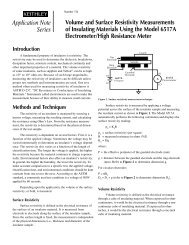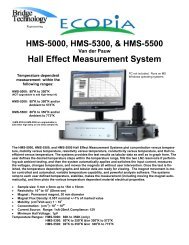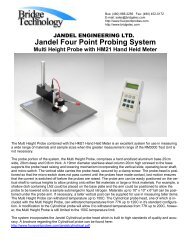CYL-RM3AR Four Point Probe System
CYL-RM3AR Four Point Probe System
CYL-RM3AR Four Point Probe System
You also want an ePaper? Increase the reach of your titles
YUMPU automatically turns print PDFs into web optimized ePapers that Google loves.
Bus: (480) 988-2256 Fax: (480) 452-0172E-mail: sales@bridgetec.comhttp://www.fourpointprobes.comhttp://www.bridgetec.comJANDEL ENGINEERING LTD.<strong>CYL</strong>-<strong>RM3AR</strong> <strong>Four</strong> <strong>Point</strong> <strong>Probe</strong> <strong>System</strong>General Purpose Portable <strong>Four</strong> <strong>Point</strong>Probing <strong>System</strong> for MeasuringSheet Resistance or Volume ResistivityCylindrical <strong>Probe</strong> withSmall NosepieceShroud combinedwith the RM3-ARTest UnitIncludes 1 meter long cableAbout the RM3-AR Test UnitThe RM3-AR Test Unit is a specialty electronics instruments designed specifically for the four point probe measurement.It features high accuracy, an excellent range, and many features which simplify the four point probingmeasurement. The following are features of the RM3-AR Test Unit:The measurement range of the RM3-AR Test Unit is from 1 milliohm-per-square (10^-3) up to 5 x 10^8 ohms-persquarewith 0.3% accuracy. The volume resistivity range is from 1 milliohm-cm (10^-3) up to 10^6 ohms-cm.The RM3-AR includes PC control software which can be used for data logging (storing data in the CSV format) andmeasurement conversion to ohms-per-square or ohms-cm.The RM3-AR reads-out directly in ohms-per-square (or toggle to millivolts) without requiring the use of the softwareor a PC.The RM3-AR has onboard non-volatile memory so that up to 50 measurements can be stored internally and thendownloaded and saved all at one time using the software. Alternately, each measurement can be saved to a PC asit is made.Continued
JANDEL Engineering LtdCylindricalThe RM3-AR has an auto-range button that can be used to automatically determine the optimum inputcurrent for a given material without using the trial and error method.The RM3-AR has forward (FWD) and reverse (REV) buttons to reverse the direction of current flow. Acommon way to determine if a measurement is valid is to reverse the direction of current flow and thencheck to see if the forward and reverse voltage readings correlate well, i.e., the values should be similar,but with the reverse current voltage being a negative value. More about reversing the input current:reversing_current.pdf<strong>Four</strong>-<strong>Point</strong>-<strong>Probe</strong>HeadAbout the Jandel Cylindrical <strong>Probe</strong>The Jandel Cylindrical probe is built to a high level of mechanical accuracy as are all Jandel four pointprobe heads. Specifications for radii, spacing, planarity, and spring load are verified by calibrated instrumentsincluding a video inspection system, an optical interferometer, and an electronic force gauge. EachJANDELprobeENGINEERINGtip is guided by upperLTD.andmanufactureslower jeweled needletheguides.CylindricalAdditionalprobeinformationto be compatibleabout probe qualitywith theJandel can Multiposition be found in the Wafer Jandel <strong>Probe</strong>, probe head the application Hand Applied notes. <strong>Probe</strong>, the Microposition <strong>Probe</strong>, the MultiHeight <strong>Probe</strong>, the Multi Height Microposition <strong>Probe</strong> and various OEM wafer mapping systems. Itis ideal for building into custom engineered four point probing systems. Jandel <strong>Probe</strong>s are built to1% mechanical accuracy. Specifications for radii, spacing, and planarity are verified using anoptical interferometer and a video inspection system. Loads are set and verified using anelectronic force gauge. Needles have upper and lower jeweled bearings. The Cylindrical probeis available with special modifications that make it usable in a vacuum environment. In it’sstandard configuration it can withstand temperatures from 77K up to 120 o C, and it is available ina modified version for use at temperatures up to 200 o C. It has a 1" diameter body and is 1.9"high (25.4mm x 48.5mm high). Weight is 40 grams.PROBE SPACINGTOLERANCEARRANGEMENTNEEDLESOTHER MATERIALSRADIIRETRACTION TOINSULATING PADPLANARITYLOADSLEADSELECTRICAL LEAKAGE25-50 mils by 5 mil increments:1.59mm. 20 mil (0.5mm) available on special order.1.00 mm 1/2(pi) cm (1.591 mm or about 62.6 mils)25 to 50 mils (0.635mm to 1.27mm) in 5 mil (127 micron) increments, also 1.0mm and+/-0.01 mmLinear or Square arraySolid Tungsten carbide Ø 0.40 mm (Ø 0.30 mm for close-spacing)45 degree included angle, phosphor-bronze connecting ligament50% osmium alloy tips available12.5 µm min. to 500 µm max. polished with 2 µm diamond0.5 mm+/- 0.025 mm or betterLow: 10-30g, Medium: 30-60gHigh: 60-150g4-way cable Teflon insulated(screened on cylindrical)10 13 ohms resistance between needles at 500 voltsCylindrical <strong>Probe</strong> Brochure Online:http://www.fourpointprobes.com/jandelcylindrical.pdf
Jandel Engineering Ltd.RM3-AR Test Unit<strong>Four</strong> <strong>Point</strong> <strong>Probe</strong>Measurement ElectronicsThe RM3-AR Test Unit reads outdirectly in ohms-per-square (or millivolts), and it includes a USB connectionand PC software to save the data as either sheet resistanceor as volume resistivity. Information regarding the PC software canbe found here:http://www.fourpointprobes.com/rm3ar_instructions.pdfSmall Shroud Installedon Cylindrical <strong>Probe</strong>NosepieceCylindrical <strong>Probe</strong> Pressure AdjustmentThe Cylindrical <strong>Probe</strong> has spring loads which are user adjustablewithin one of three ranges. The probe shown here has been factoryset to 100 grams per tip, however, the user can increase the load to ashigh as 150 grams per tip or as low as 60 gram per tip by moving thered Teflon knob towards either the “H” for higher or towards the “L”for lower. Cylindrical <strong>Probe</strong> Brochure Online:http://www.fourpointprobes.com/jandelcylindrical.pdf
















